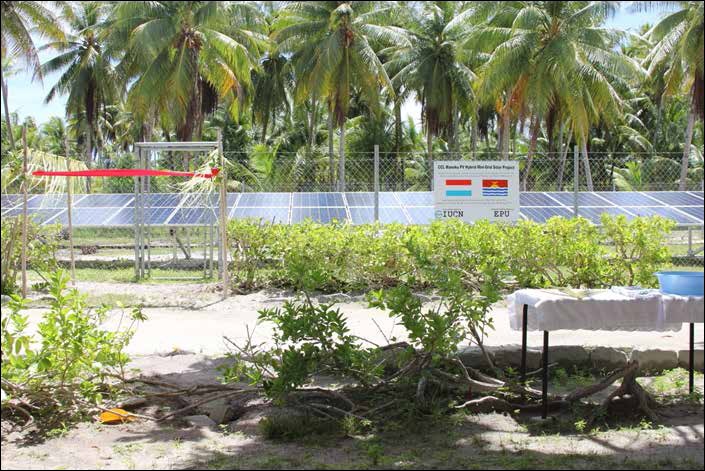Solar PV system installed at the Christian Community Leaders Manoku School
On the remote outer island of Abemama in Kiribati, the Energy Planning Unit of the Ministry of Works and Public Utilities (MWPU) recently completed the installation and commissioning of a 25kW solar PV system at the Christian Community Leaders (CCL) Manoku School.

Photo: IUCN Oceania / Andrew Irvin
The project is implemented by the International Union for Conservation of Nature – Oceania Regional Office (IUCN ORO), and funded by the Grand Duchy of Luxembourg under the flagship of the Energy, Ecosystems and Sustainable LivelihoodsInitiative (EESLI) of therecently retitled Climate Change Mitigation and Disaster Risk Reduction (CCM and DRR) Programme. The key objective of the project was to offset the existing reliance on imported fossil fuels by the Manoku community and create increased opportunities for the residents to engage in study, productive work, and income-generating activities when it is dark.
CCL was established to train missionaries for the Catholic Church. Residential students are married couples, recruited for the twoyear programme from throughout Kiribati. They are accompanied by staff: missionaries of the Sacred Heart Community and Sisters from Our Lady of the Sacred Heart community. The facility is designed to accommodate up to 500 individuals. Hence, the provision of renewable energy for CCL, Manoku, affects many Abemama residents, and during the ceremony celebrating the commissioning of the installation on 6 May 2017, attendees from the community were given the opportunity to speak and commemorate the occasion.
The primary objectives of the project were planned as follows:
- elimination of diesel fuel use for electrification purposes;
- 24-hour access to electricity services for the community;
- improved energy efficiency through conversion to LED lighting fixtures; and
- increased income generation through sales of processed and frozen seafood.
The Energy Planning Unit ensured that the project was aligned with the Kiribati Development Plan 2016–2019, the Kiribati Nationally Determined Contributions, the Kiribati National Energy Policy, and the Kiribati Joint Implementation Plan. It has served as another success for the Energy Planning Unit, and marked the first point of collaboration between Kiribati and EESLI through IUCN’s CCM and DRR Programme. Given the timely and successful implementation of project activities, the Energy Planning Unit and IUCN have discussed opportunities for subsequent projects, investing in renewable energy and energy-efficiency technology in partnership with other stakeholder organisations and agencies operating in Kiribati.
As for the 25kW installation, supply of the system was opened for tender, and Clay Energy, based in Suva, Fiji, made the successful bid. Upon arrival of the system in Kiribati, the installation itself was conducted by Energy Planning Unit staff. They were supported by CCL staff residents, who provided infrastructural support in the form of the control room housing,and fencing to contain all the system components. Participating CCL staff members were also trained by MWPU personnel, and will be attending to the operation and maintenance of the system between government visits to monitor the performance and state of the installation. As of 6 May 2017, the Sunny Island Inverter display provided a read-out of 1.870MWh generated in 44.34 days since the system was installed. This means, given the specific CO2 emission rates of diesel (0.24kgCO2 /kWh), 448.8kg of CO2 emissions have already been mitigated. Extrapolating from the current figures, it is projected that 3.694 tonnes of CO2 will be avoided per annum, depending on variations in solar irradiance over the course of the year.
1. http://www.engineeringtoolbox.com/co2-emissionfuels-d_1085.html
By Andrew Irvin, Energy Programme Officer, IUCN (Andrew.Irvin@iucn.org)
